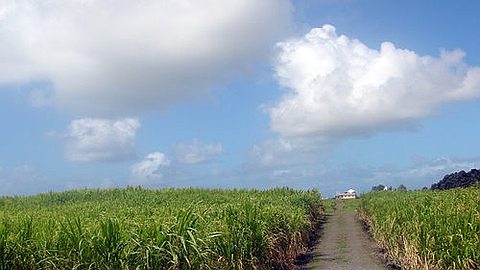The Future of Small Cane Planters

Some 25,000 arpents of these belong to sugar estates who have converted these agricultural lands to residential and commercial zones – real estate morcellements, construction of hotels and big shopping centres, and the like. The remaining
15,000 arpents belong to small planters. Most of them, have been compelled to abandon their lands to fallowness. While, it is true a small percentage of these have been used for housing purposes, more than 14,000 arpents have just been left abandoned and unexploited.
The reasons are many : low, even negative, return on investment high increase in prices of fertilizers & herbicides and in labour wages unavailability of labour financial constraints poor or lack of institutional assistance aspects of land-quality – rocky, sloppy, mountainous, marshy, etc age and health constraints of the small planters plots frequently affected by droughts, fi re, floods, water loggings, landslides, wild and stray animals, pests and diseases.
But the main cumulative cause is the ever-widening gap between the investment costs to the small planter and the low/negative return. Total cost to him for the production of 1 ton of sugar for year 2011 was Rs 17,500, while the revenue generated was only Rs 15,532, i.e a loss of Rs 1,968 for every ton of sugar produced. Even with the fall in the price of sugar on the world market and the resulting acute decrease in sugar-income, the sugar – or, more appropriately, the cane-business is still profitable. It is only that the revenue derived is very unequally distributed. With the small cane planters actually losing money !
Revenue from cane cultivation comes principally from 3 of its products : sale of sugar sale of bagasse sale of molasses.
Sugar
In 1972, we had 24 sugar-mills operating, with these mills getting in lieu of payment for mill-management and operation, which consisted mainly in the crushing of the cane and extracting its sugar, 26 kg out of every 100 kg of the planter’s sugar so produced. The ratio 26/74 was, at that time, considered reasonable, given the management and operation costs of 24 mills. Today, we have only 6 mills in operation. Centralization means management and operation costs have been reduced by nearly 4 times. But the in lieu payment has been lowered to only 22 kg ! It is quite clear that small planters are very unjustly still being made to pay the management and operation costs of 18 no longer-existing mills. Centralization was meant to reduce production costs. But whatever the advantages so obtained , they have gone to the mill owners only. Not to the small planter. «En passant», centralization has also resulted in further increases in transportation costs to the small planters.
Refineries were set up with the idea that, instead of selling our comparatively cheap price fetching unrefined brown sugar, we would sell at a much better price our refi ned white crystallized sugar. These refining procedures required heavy investment in terms of know-how, machines, tools and equipment. Banks and institutions (local and foreign) financed these costs, with the Government guaranteeing 100% of the whole finance-loan.
Perhaps in prevision of better crops in coming years, or perhaps with a hidden agenda of importing raw sugar from abroad, the capacities of the refineries plants were doubled compared to the current estimated crop-yield. And here is «la cerise sur le gateau»: the planters are made to contribute to the running cost of these refineries, based, not on the actual amount of raw sugar refined, but on the refining capacity (i.e. more or less double amount). This as per «enn kontra-beton» between the refineries’ owners and the Government. The planter, perfect «dindon de la farce», is still being paid at raw-sugar rate and not on the proceeds of sales of refined sugar !
The Mauritius Sugar Syndicate has the monopoly for the sale of Mauritian sugar. Who are the buyers ? What prices do our sugar fetch ? Complete opacity, complete secrecy surrounds the transaction. It is considered unwise to let the small planter into its secret dealings. When it is also the small planter’s sugar which is being sold !
A small anecdote : The MSS sells sugar to retailers on the local market. The maximum credit time-limit given to them, as per written Regulations, is 15 days. The last Financial Report submitted by the Syndicate indicates that a sum of Rs 500 m is overdue from these retailers. This means that within a period of 15 days, MSS has sold (at an average of Rs 30/kg) more than 16,666,000 kilos of sugar to retailers, and this without taking into account the amount sold cash. If we divide 16,666,000 by our population total (1,200,00), we have each single Mauritian consuming nearly 14 kg of sugar within 15 days, nearly 1kg/day. No surprise, Mauritius rates topmost on diabetes affliction. Or, is there some hoaxy-poxy game going on ?
Then look at this paradox : The small planter gets Rs 15,532 per ton of sugar produced, i.e Rs 15.53 /kg. Then he, the initial producer of sugar, is made to pay, as consumer, some Rs 35 – Rs 40/kg of the same sugar (albeit, refined) !
Bagasse
The small planter is informed that it requires the processing of 3 tons of his cane to leave him 1 ton of bagasse-residue. He is then paid Rs 24/ton of this residue. This same is sold at about Rs 120/ton to the Independent Power Producers (IPP), who through a combustion process produces electricity therefrom at the rate of I ton of bagasse yielding 125 KW. The CEB purchases this electricity at the rate of around Rs 5/KW, i.e. Rs 625/ for 125 KW.
Agreed that this electricity-producing process can be costly. But, even then, Rs 625 compared to the planter’s miserable Rs 24 !? And as to the mill owner, the whole process does not cost him anything, but he, nevertheless, realises a cosy Rs 96 profi t per ton. «Lor ledo ti-planter!»
Molasses
Small cane planters are being paid Rs 2,200 per ton for their molasses. The same are being sold for export or to local distillers at more than Rs 7,000/ per ton. Again, these molasses do not cost anything to the millers but they, non the less, are making a safe Rs 4,800 per ton profi t. Again, «lor ledo ti-planter!»
All this is a flagrant case of gross injustice and capitalistic exploitation of the uninformed simple-minded small planters. And, this has been going on for quite a long time. Who says highway robbery no longer prevails here ? Or, that serfdom and slave-exploitation mentality is inexistent in Mauritius ?
What then is the future of the small cane-planter ? Is he doomed to disappear ? Is his long experience and rich knowledge accumulated and passed on de pere en fi ls over the last 200 years or so – make no mistake, this knowledge DOES constitute a National Heritage, a National Wealth – allowed to fade away ? And can the country afford to allow 40,000 arpents of its already scarce agricultural lands to go fallow ? This, when we are faced with serious food insufficiency ? And, when we are already relying on food produced in foreign countries for more than 85 % of our needs ?
Recommended Measures
To prevent these from happening, urgent and active measures have to be taken :
- A more reasonable adjustment of the present 22/78 ratio as to the allocation of the shares of sugar produced going to the miller and to the small planter.
- More equitable share on the proceeds of sales of byproducts bagasse and molasses.
- Direct shares-holdings to the small planter («de grace», not through SIT!) in business concerns involved in exploiting products and by-products of cane (IPP, Distilleries, Refineries, Ethanol Producers, etc.)
- Government should come up with an Agricultural Land Policy. A certain percentage of land and certain specified zones can be decreed agricultural lands/zones and are to remain so for at least the next 50 years. Maybe, better still, the Constitution may be amended to make this a sacrosanct Constitutional Law.
- A Land Bank be set up for abandoned agricultural lands. Owners who, for one reason or other, cannot continue to exploit their plots of agricultural land can be law-bound to “fix-deposit” their plots (against a yearly bail-rent) for a given number of years with the Land Bank. The Bank will re-rent these (mostly clustered together) to other planters and farmers for food production and animal farming.
- More transparency in the dealings of the Mauritius Sugar Syndicate.
This is not a problem solely for the planters. It is in fact a national problem and it concerns every citizen. It directly puts in question our National Food Security.





